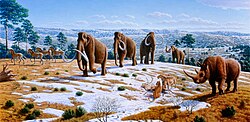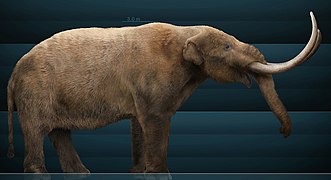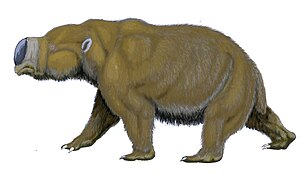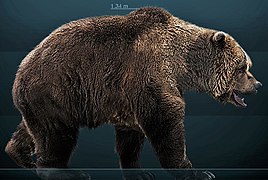Pleistocene
The Pleistocene is a division of the geological time scale that belongs to the Quaternary period; within this, the Pleistocene precedes the Holocene. It begins 2.59 million years ago and ends approximately 11,700 years ago. The term Pleistocene derives from the Greek πλεῖστος (pleistos "the most") and καινός (kainos "new").
The Pleistocene covers the last ice ages, including the Younger Dryas episode (12,000 BC - 10,000 BC). The Pleistocene corresponds to the archaeological Paleolithic.
Divisions
The Pleistocene is divided into four ages or stages: Gelasian, Calabriense, Chibaniense and Tarantiense. The Gelasian age was recently added to the Pleistocene from the Pliocene; In this way, the International Commission on Stratigraphy advanced the beginning of the Pleistocene from 1,806 to 2,588 million years, in order to include all recent glaciation cycles. Until the incorporation of the Gelasian and the process of formalizing the stratigraphic scale Internationally, the three ages into which the Pleistocene was divided were known as the Lower, Middle and Upper Pleistocene, terms to be extinguished, but which are still used for the Calabriense, Chibaniense and Tarantiense respectively.
Paleogeography and paleoclimatology
Initially, cooling and progressive aridity engendered a world much more like today. Inside the Arctic Circle, the tundra extended over the permafrost, to the south of it grew the taiga and still further south, the prevailing aridity led to the replacement of chaparral by desert and semi-desert; the savannahs were replaced by temperate grasslands. In the Late (Upper) Pleistocene, modern humans (Homo sapiens) appeared in Africa.
During this period the sea receded from almost the entire Iberian Peninsula, leaving an increasingly reduced gulf in the Guadalquivir and Murcia and remains of beaches in Huelva and Catalonia. In the interior the old basins still function and new fluviolacustrine ones appear. Only in the Upper Pleistocene in the mountains and northern peninsular strip are there indications of glacial phases.
The Ice Ages
During the Pleistocene, large tracts of land were covered with an immense layer of ice, a phenomenon called glaciation. In some periods the size of the ice sheets was reduced and the climate became warmer. These periods are called interglacials.
In the last million years, there were four main glacial periods in Europe and they are named after four tributaries of the Danube, in which, for the first time, their deposits were identified: Günz, Mindel, Riss and Würm (the more recent). In the United States, the ice ages are called Nebraska, Kansas, Illinois, and Wisconsin respectively. With the recent inclusion of the Gelasian within the Pleistocene, two new Donau and Briggen glaciations were included.
Due to the climatic conditions, the polar caps grew and the ice advanced towards the 40th parallel in some areas. The sea level dropped by approximately 100 meters and the fauna and flora developed according to the climate.
Climate changes
Throughout the Pleistocene, extensive sheets of glacial ice covered the highest latitudes of the planet, especially in the northern hemisphere, alternating with times when these areas were partially uncovered.
Earth is currently going through an interglacial period that began in the late Pleistocene, about twelve thousand years ago. At high latitudes, mean temperatures are about four to six degrees above those of the last glacial period at its peak. The present interglacial period is proving particularly colder than most previous ones, during which hippos, elephants and monkeys were able to thrive in present-day England.
In the northern hemisphere there are several conditions that favor glaciations as there are large land masses very close to the Arctic, capable of channeling the glaciers to the south. Antarctica, on the other hand, although it has conditions as cold as those of the north, is separated from the southern continents by a circumpolar ocean, which extends between 55 and 60 degrees of latitude; this separation from other southern continents reduced glaciations in the southern hemisphere. The Sea of Hoces between Antarctica and South America has always been free of glaciers.
Causes of Ice Ages
The connection between the subcontinents of the Americas, which occurred about 2.5 million years ago, was a watershed event. This event altered the patterns of oceanic and atmospheric circulation, especially affecting the warm water currents that previously continued southward and which, as a result of that event, were diverted northward (Gulf Stream). The formation of new glaciers requires an abundance of atmospheric water that generally comes from an increase in rainfall, associated with the passage of warm currents along the continental margins. In this case, the phenomenon appears linked to the formation of the Arctic ice cap.
The rhythm of the glacial periods is related to three astronomical cycles, which affect the amount of solar radiation received by the Earth. These cycles are determined by two factors:
- The slow and regular variations in the degree of inclination of the Earth axis and its orbit around the Sun. Each cycle has its own “tempo”, with its maximums and minimums. The joint action of both, whose combination generates extreme thermal effects both maximum and minimal, is known as Milankovich cycles and occurs regularly every few dozen years. It is likely that these cycles have influenced the Earth's weather throughout its history, but it was the formation of the Arctic Ice Layer that enabled this series, still unfinished, of glaciers to be triggered.
- The albedo or amount of heat reflected by the Earth, which is greater with the increase of the surfaces covered by the ice (the white color reflects the heat). The image of the pleistocenic glacial phases with long and crude global winters, in which animals perished at the intensity of the cold and the difficulties of finding food is wrong. During those episodes, Arctic conditions did not prevail in all areas of high latitude. Even it is likely that the winters were not much colder than they are today; what made the difference were the summers, the cooler and incapable of melting the winter snows.
Changes in vegetation resulting from climate change had a more definitive impact on life. At the height of the last ice age, around 18,000 years ago, there was an enormous amount of water held by glaciers in a frozen state. This circumstance determined an increasing aridity in the tropics. The rainforests of the tropics dwindled, to occupy a smaller area than they would occupy just after the ice age and just before humans became farmers. The invasion of the deserts pushed the large mammals of Australia and Madagascar, adapted to a tropical existence, to the limit of their survival given the impossibility of migrating to other latitudes. In the other tropical zones, the inhabitants of the jungle were confined to ever smaller refuges, with food shortages and strong competition that caused major extinctions.
Paleontology
The predominance of mammals was consolidated, and some of its most prominent representatives are Glyptodon and Smilodon. The genus Mammuthus was maintained for much of this period. Typical animals of this era were the mammoth, reindeer, polar bear, woolly rhinoceros, etc. The predominant vegetation was similar to that of today's tundra or cold deserts that are covered with mosses and lichens. In the warm interglacial stages, rhinos and steppe horses, hippopotamuses and big-tusked cats appeared. There was also a fauna indifferent to the climate (moose, foxes, wild cat, bison, etc.)
Extinctions
Many Pleistocene mammals are considered typical of the ice ages that affected large areas of the world (the mammoth, the woolly rhinoceros, the giant Irish deer, the aurochs, or the cave bear). All of them disappeared in relatively recent times, and there is currently considerable interest in trying to establish the causes of their disappearance. Meanwhile, other mammalian species remained widespread during times such as the last glacial maximum, such as the wolf (Canis lupus).
The Pleistocene epoch is marked by five or more major glacial periods, during which ice from the polar cap covering the North Pole moved southward, reaching as far south as Germany and England, North Asia, and Canada. The ice also advanced starting from the Himalayas and the Alps and climatic changes occurred throughout the rest of the world. Between these glacial periods were intervals of warmer weather, called "interglacials," during which elephants, hippos, and humans could roam as far as what is now England.
The last ice age ended about 11,000 years ago. At this time, the mammalian faunas of all continents underwent major changes.
- In South America, 46 genera (80 %) were extinct, including rodents, carnivores, pecaris, camels, deer, dentures, lithopterus, notungals, horses and mastodons.
- In North America, for example, 73% of the large mammals (33 genera) were extinct, including all the prognoscide (mamutes, mastodons and gonfosters), the horses, tapirs, pecaris, camels, lazy and glypthodants, as well as the deer, bison and among those of predators, the American lotromus
- In Australia, 55 species were extinct, including some equidnas, marsupial carnivores, wombats, dipertontos, kangaroos and wallabis.
- On the other hand, in Europe the losses were not so serious. Some extinct, such as the mammoth, the lanute rhinoceros or the giant deer, but other species, such as the horse, the hippopotamus, the almizclero, the hyena or the saiga antilope, only saw their restricted distribution to other parts of the world.
- Extinctions during this time in Africa and Asia were equally modest.
Palaeontologists attribute these extinctions to a large number of causes, polarized into two main groups:
- Climate causes: One explanation is that the climates and the environment quickly changed by retracting the polar caps and the large mammals, in particular, were very vulnerable to these disturbances (regression of the savannah and advance of the deserts).
- Excessive hunting hypothesis: The second theory argues that the expansion of human populations exerted special pressure on large mammals, which were exterminated by hunting.
Excessive hunting advocates point to a good correlation between the expansion of human populations and the extinction of large mammals. They also claim that, had there been such drastic climate changes, there should have been extinctions among smaller animals and plants. Likewise, they wonder why climatic changes had minor effects in Europe, and why previous ice retreats did not cause extinctions.
On the other hand, supporters of the climate hypothesis denounce the lack, in the sites of that time, of archaeological evidence or indications of large hunts and the fact that humans invaded North America and Australia long after it began to occur the bulk of these extinctions. They also wonder why certain species, which in all probability were not hunted, went extinct anyway.
Human development
The Pleistocene corresponds to the Paleolithic stage of human development. The way of life was very simple hunter-gatherer; with it they obtained food, clothing, firewood and materials for their tools and cabins. It is characterized by the use of carved stone tools, although other tools made of other materials such as bone, horn, wood, leather, vegetable fibers, etc. were also used. The manufacture of stone tools began in the Lower Paleolithic with the appearance of Homo habilis, which was probably responsible for the Olduvayense culture. Hunting was not very important at the beginning of the Paleolithic, with gathering and scavenging predominating. As the human brain develops, hunting becomes more important. Homo erectus produced a lithic industry that belongs mainly to the Acheulean and probably knew the use of fire. They lived in small groups or bands and there should be no division of labor or specialization, except those due to physical differences between different individuals.
Homo neanderthalensis was a species well adapted to extreme cold. The style of Middle Paleolithic lithic tools manufactured by Neanderthals belongs to the Mousterian culture and to the Levallois method, which consists of the particular preparation of the lithic core to obtain flakes by default. The Upper Paleolithic is associated with the appearance of Homo sapiens. and other materials such as harpoons, darts, hooks, needles with eyes, the oil lamp, ropes, and the first piece of pottery.
Contenido relacionado
Cabezabellosa de la Calzada
VI millennium BC c.
Parcel














